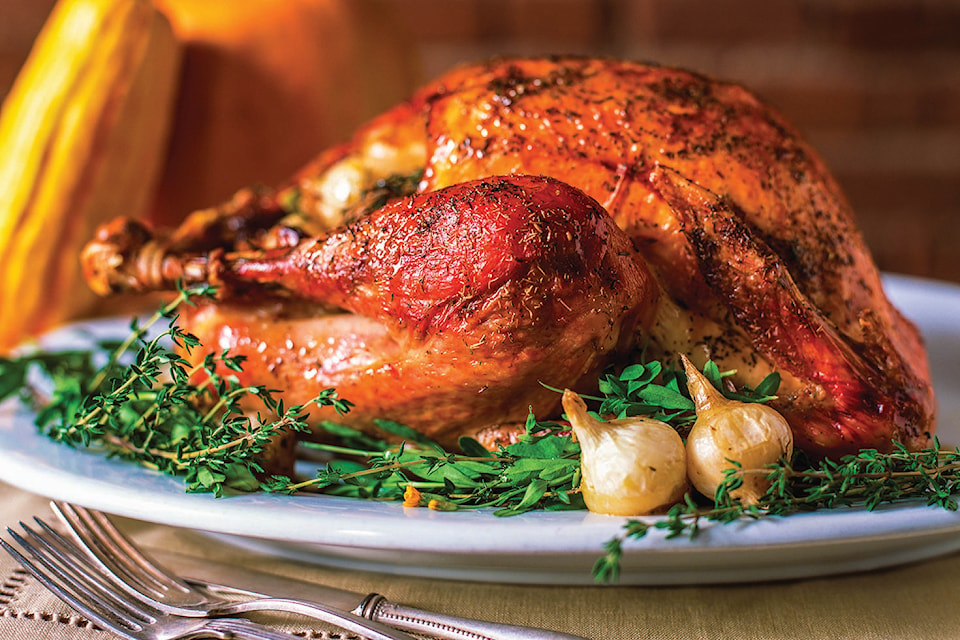By Chef Dez/Special to Black Press Media
Have you ever had the misfortune of tasting gravy that was bland, watery, or as starchy as dragging your tongue across a pile of raw flour?
To say the least, it is not pleasant, and a far cry from serving its purpose: to enhance the food being served.
To assist you in avoiding this mishap at your Easter dinner table [regardless of how small your dinner party is this year – amid the COVID pandemic], let us discuss the basics in perfecting gravy.
Gravies are considered sauces made with the pan drippings of either meat or poultry, and thus basics of sauce making are fundamental knowledge.
The functions of sauces are to add flavour, moistness, richness, and appearance to prepared foods.
To achieve this, we need three elements of the sauce or gravy: a liquid, a thickener, and flavour.
I realize ham is also very popular, but for this Easter example, the focus will be on turkey gravy.
The liquid for this gravy is simply the juice from the turkey with additional broth and/or wine.
The thickener will be a roux (pronounced ‘roo’), a cooked combination of equal weighed amounts of fat and flour. Additional flavours will be created from roasted vegetables, herbs, and seasonings.
Always cook turkey on a rack inside the roaster as it prevents the bottom half of the turkey from boiling in its own juices.
Below the rack should be a combination of a few bay leaves with rough chopped onion, celery, carrot, and garlic.
As the turkey cooks the liquid is needed for basting. However, excess juices should be removed occasionally (and reserved) to aid in the caramelization of the vegetables.
PREVIOUS COLUMN: Cauliflower options help keep true to New Year’s resolution
Once cooked, remove the turkey from the roasting pan, drain, and reserve the remaining liquid and allow the fat and juices to separate.
Add a bit of the fat back to the roasting pan along with some flour and cook on a medium-low heat stovetop with the vegetables for a few minutes.
This process will cook out the starchy raw flour taste and help in the final browning of the vegetables. It should be fairly thick and pasty.
Slowly deglaze the pan with some white wine or broth.
Deglazing is the process of removing the browned bits of flavour from the pan and incorporating them into the sauce.
Incorporate the reserved turkey juices (not the fat) and additional broth (or additional broth and white wine) gradually to avoid lumping.
While heating through, continue to add enough broth/wine until you have reached the thickness that you want to achieve. Remember, the full thickening power of the roux will not take effect until the gravy reaches a full boil.
The vegetable pieces and herbs can now be removed by the aid of a wire mesh strainer. Taste and season the gravy with salt and fresh cracked pepper before serving.
Additional herbs such as thyme, sage, and oregano can be used, but should be in minimum amounts to prevent from overpowering the gravy.
Dried herbs should be added during the cooking process of the roux, as they will need re-hydration time to release their flavour. Fresh herbs are more delicate and should be added with the liquid, once the pan is deglazed, for optimal taste, and fragrance.
Whatever type of gravy or sauce you are making, remember one important rule: always create depth of flavour by adding a variety of complimenting tastes rather than just one bold main ingredient. For example, a tomato sauce made only by reducing diced tomatoes will only taste like tomatoes. However, add wine, broth, onions, garlic, herbs, etc. to the cooking process and your sauce will have character.
PREVIOUS COLUMN: CHEF DEZ ON COOKING – Celebrate St. Patrick’s Day with Irish Fare
.
Dear Chef Dez:
I know if my sauce or gravy is too thick I just add more liquid, but what if it is too thin? How do I add more flour without it going lumpy or tasting starchy?
Sharon G., Abbotsford
.
Dear Sharon:
Mix equal amounts of flour with room temperature butter into a paste and whisk in small amounts of this paste to your sauce while continuing to cook until the desired consistency is reached.
The fat of the butter mixed with the flour will separate the starchy particles from each other and prevent lumping.
The continued cooking will eliminate the starchy taste, and the butter will also add extra sheen to your sauce’s appearance.
To chefs, this paste is called a ‘beurre manié’ (pronounced burr mahnyay) in case you want to impress your friends and family!
.
– Chef Dez is a food columnist and culinary instructor in the Fraser Valley. Visit him at www.chefdez.com. Send questions to dez@chefdez.com or to P.O. Box 2674, Abbotsford, B.C. V2T 6R4
.
_________________________________
Is there more to this topic?
Email: news@langleyadvancetimes.com
Like us on Facebook or follow us on Twitter
_________________________________

